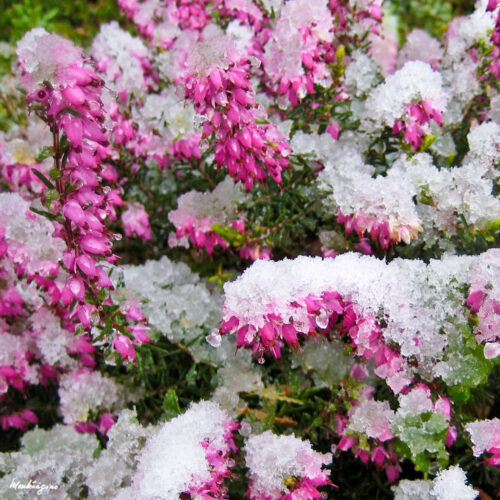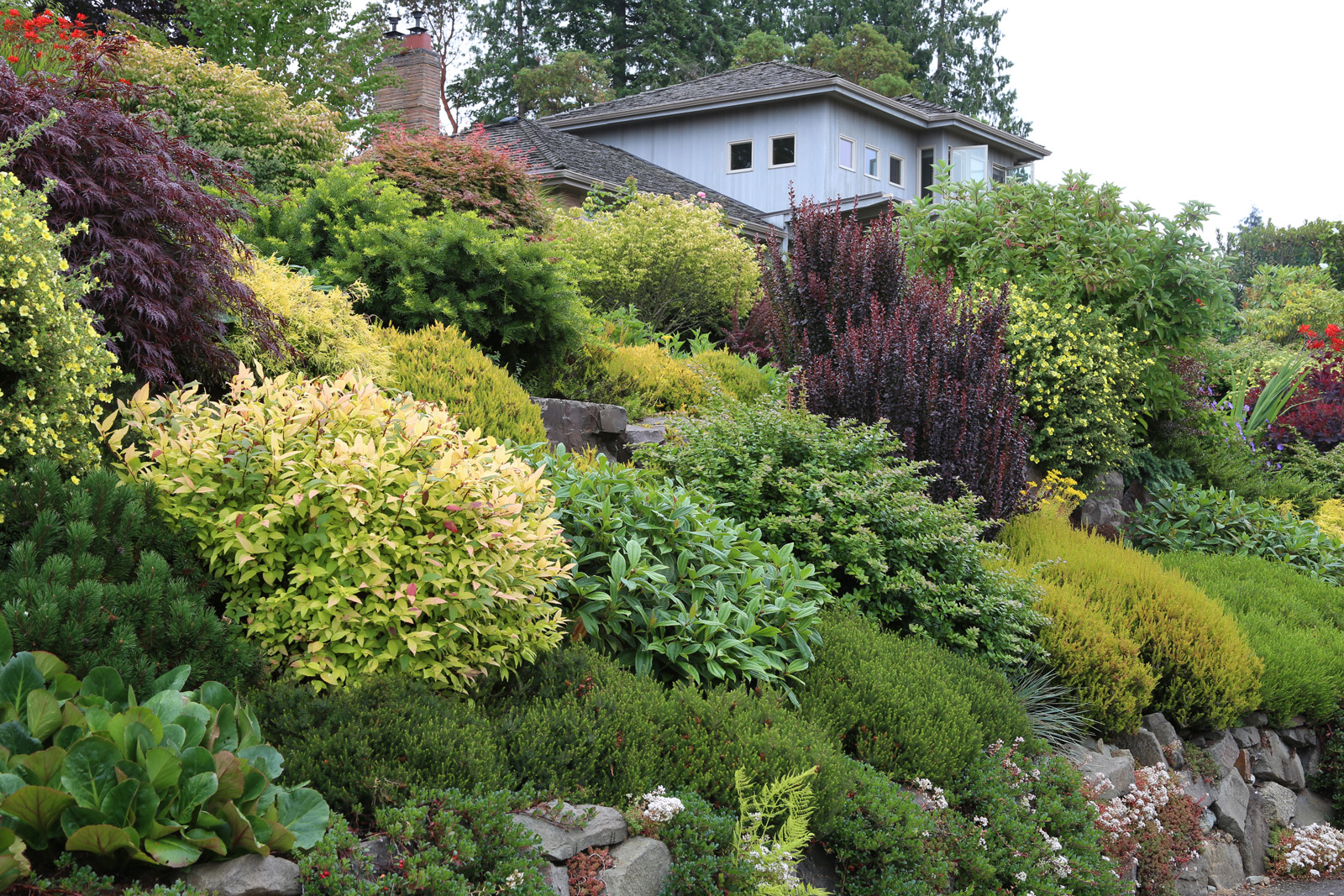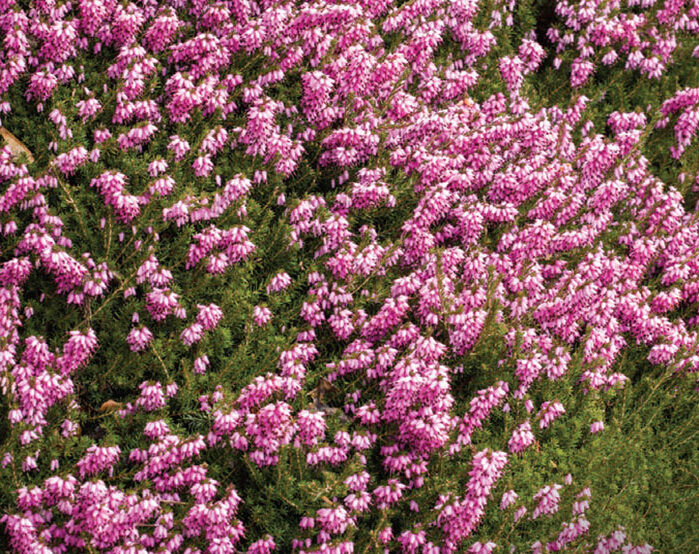I often hear folks say that they hate heaths (Erica spp. and cvs., Zones 5–8) and heathers (Calluna vulgaris and cvs., Zones 5–8), their earlier blooming cousins. The most common complaints are the woody, leggy shape they develop (mostly after years of neglect) and how they outgrow the space they’ve been provided rather quickly. The same people who complain about heaths and heathers admit they have no knowledge of how to care for them (Learn all about caring for heaths and heathers here). But while these plants do need certain conditions and annual care, they are not divas.
These deer-resistant and salt-resistant evergreens create a beautiful tapestry for every season, with a wide variety of colored foliage and little bell-shape flowers that range from white to deep pinks and purples. They are also an attractive, evergreen ground cover that excels at shading out weeds.

Heaths provide that winter pop of bright color when few other plants are in bloom. I like to use them in ribbons throughout the garden whenever possible, which creates more interest and can make a garden seem a lot larger.
Heathers provide any garden with a blast of glowing colors from late spring into midsummer. They also display stunning winter foliage colors of chartreuse, coppery oranges, and burgundy. See below for some of my favorite options.
Heaths that shine in winter

‘Springwood Pink’ heath
For a winter border, the hands-down favorite is ‘Springwood Pink’ heath (Erica carnea ‘Springwood Pink’, Zones 4–8), with its brilliant pink blooms that last from January until May. At a mature height of 6 inches and a spread of around 16 inches, ‘Springwood Heath’ is a perfect choice to line the edges of paths and driveways.
‘Furzey’ Darley Dale heath‘Furzey’ Darley Dale heath (Erica × darleyensis ‘Furzey’, Zones 7–8) is good for a more mature landscape. It has that old-fashioned, traditional heath look about it. It fills in quickly, sporting lilac flowers with dark purple tips in late winter and on into spring. Growing up to 2 feet high and wide, ‘Furzey’ is on the larger size if it’s left to mature in a backdrop. |

‘Mary Helen’ Darley Dale heath
‘Mary Helen’ Darley Dale heath (Erica × darleyensis ‘Mary Helen’, Zones 7–8) has lavender blooms, but it’s the bronze-to-gold foliage that makes it a perfect, all-season winner. It won’t quite reach a foot tall, but it will spread up to 18 inches. This species of heath is more tolerant of summer humidity and can handle a Zone 6 winter with proper protection (see sidebar, facing page).

‘Kramer’s Rote’ Darley Dale heath
If you’re looking for eye-catching winter color, then ‘Kramer’s Rote’ Darley Dale heath (Erica × darleyensis ‘Kramer’s Rote’, Zones 7–8) is the one for you. It has the darkest, deep purple-red of them all. It grows quickly to 3 feet tall and 4 feet wide. Because the color is so strong, it is best used in groups; otherwise, it will look like polka dots.
Heathers are the stars of summer

For a summer splash of bright color, heathers often steal the show in any garden. For a larger variety with some serious drama, I choose ‘Firefly’. In spring, this plant has bright chartreuse and primrose golden foliage that goes perfectly with my Magic Carpet spirea (Spiraea japonica* ‘Walbuma’, Zones 4–9). Late summer brings beautiful mauve flowers. Expect this heather to grow to around 18 inches tall and wide.
‘Wickwar Flame’For a much shorter variety in the same color palette, try ‘Wickwar Flame’, which provides a burst of bright golden yellow and orange foliage with burgundy tips in summer. The tiny purple flowers are a bonus. |

‘Winter Chocolate’
My newest favorite—and my garden is full of it now—is ‘Winter Chocolate’, which has foliage that changes colors from bright orange with burgundy tips in winter into rich gold in summer. It appears to be growing very slowly, however. Eventually it will reach around 8 inches tall, with a width about twice that.

‘Spring Torch’
Another favorite is ‘Spring Torch’, with its deep lilac blooms and rich, emerald green foliage. This color makes it good for carpeting. It grows 12 to 18 inches tall and up to 2 feet wide. It is slow to spread and easy to shear.

‘Blazeaway’
‘Blazeaway’ is a slow-growing heather with a thick matte look. It gets 12 to 18 inches tall and wide and has lovely pink stems with lilac flowers in summer and warm, copper-colored foliage in winter. Plant it in groups for the best show.

‘Silver Knight’
For a more elegant and subtle presentation, try ‘Silver Knight’. It has frosty, silver-colored foliage and soft, lavender blooms. With an upright habit, this heather is well behaved, reaching 16 inches tall and just a bit wider.
| Design |
Putting heaths and heathers to work

Because these plants offer such steady color, they are extremely versatile design tools. My preferred use is planting them in groupings. I think of using a wide brush stroke, with three, seven, or nine plants at a time in swaths. This creates a carpeting effect when they all knit together.
Heaths and heathers provide year-round interest and coverage that’s excellent for suppressing weeds. Be sure to read the tags, and leave enough room for the plants so that when they reach maturity they will not be overcrowded. Plan a way in and out of your garden bed so that you will be able to shear your heather after the blooms begin to fade without stepping on them. You can hide paths between your plants.
*Invasive alert: Japanese spirea (Spiraea japonica)
This plant is considered invasive in GA, IN, KY, PA, and TN.
Please visit invasiveplantatlas.org for more information.
Stacie Crooks is a landscape designer in Seattle.
Photos, except where noted: David Perry
Sources:


